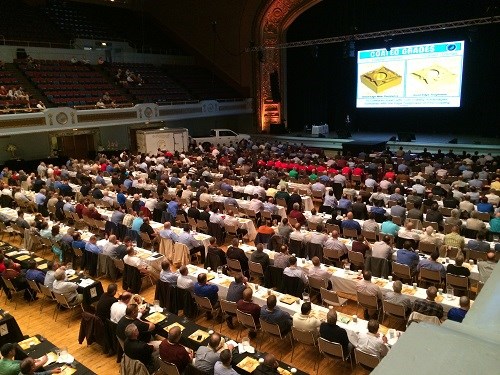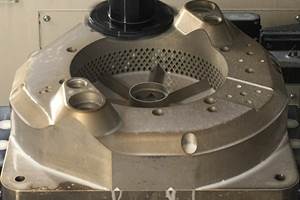IMC Group President Says Tool Value Comes from Productivity
Only cutting tool productivity can reduce other factors affecting part cost. Jacob Harpaz made this point at a recent Ingersoll Cuttings Tools event in Cleveland.

The Ingersoll Cutting Tools event was held at the historic Cleveland Public Auditorium.
An improved cutting tool could deliver its improvement in any of three different ways. That tool could be cheaper, it could provide longer tool life or it could deliver greater productivity. IMC Group President and CEO Jacob Harpaz says go for the productivity. Now is the time for this.
That was his message at an Ingersoll Cutting Tools 125-year anniversary event last week. The event was held in Cleveland, birthplace of the cutting tool company. Now based in Rockford, Illinois, Ingersoll is today part of the IMC Group, which also includes cutting tool makers such as Iscar, Taegutec and Tungaloy. In presentations throughout the day-long event, Mr. Harpaz described various offerings in Ingersoll’s milling, turning and holemaking lines to an audience of about 850.
Business is good. After Ingersoll’s sales dropped in ’09, following the crash, the company had sales in ’10 that surpassed ’08. Then, after a flattening from ’11 to ’12, business has been increasing through the past two years. All of this is relevant to his message because many machining facilities have seen something like this same pattern of activity. Business is now strong enough in machining, particularly in North America, that any open time on a plant’s machine tools often can be filled. That means far and away the most lucrative return to get from a cutting tool is an improvement in productivity.
Shops do not necessarily see this, Mr. Harpaz says. Because a cutting tool is a consumable that is purchased again and again, its price is seen frequently, and therefore seems more significant than it might be. In most manufacturing processes, the impact of fixed costs and labor costs are actually much higher.
Specifically, for a representative machined part, he says the cost of machinery represents 26 percent of the cost of machining a part. Overhead represents 21 percent of the unit cost of machining. Labor and raw material account for 28 and 22 percent, respectively. Meanwhile, the cost of cutting tools accounts for just 3 percent.
That such a low share of the total cost comes from cutting tools has significant implications. Dropping the price of the tool by 20 percent, as big a change as this might seem, would deliver only a 0.6-percent unit cost reduction. The seemingly even greater change of increasing the life of the tool by a factor of 2 would save only 1.5 percent. But increasing productivity would increase the number of pieces the shop can produce in the same period of time, meaning the labor cost, overhead cost, and machinery cost per piece all go down. Increasing productivity by 20 percent thus produces a savings of 15 percent overall. Productivity increase delivers far and away the greatest savings, he says, because it is the only type of cutting tool improvement that can affect all the other cost factors.
The Ingersoll event showcased various new or improved cutting tool offerings aimed at this productivity increase. For example, the company’s TC430 whisker-reinforced ceramic insert for turning superalloys is more expensive than carbide tools used to turn these metals, but it is so much more productive that the cost increase is easily justified. (See video of the tool turning Inconel.) A couple of the company’s unusual offerings for productivity include:
- The Chip Surfer milling tool line, which consists of tools with changeable tips. The time savings here comes from quickly being able to replace a worn tool or switch to a different tool type just by changing the tip.
- Coolant-driven spindles able to deliver 40,000 rpm on a lower-speed machine for small tools requiring this rotational speed.
The most prominent product line at the event was the company’s “Gold Rush” line, which consists of tools benefiting from a post-coating treatment that enhances performance. Tools in this line can deliver long tool life compared to tools without the surface treatment. However, the more profitable use of the tooling is to let tool life remain steady, he says, and instead use the performance enhancement to increase speed and feed rate. Now is the time to go for productivity.
Related Content
10 Ways Additive Manufacturing and Machining Go Together and Affect One Another
Forget “additive versus subtractive.” Machining and metal additive manufacturing are interconnected, and enhance the possibilities for one another. Here is a look at just some of the ways additive and machining interrelate right now.
Read MoreHow to Troubleshoot Issues With Tool Life
Diagnosing when a tool is failing is important because it sets an expectation and a benchmark for improvements. Finding out why gives us a clue for how to fix it.
Read MoreQuick-Change Tool Heads Reduce Setup on Swiss-Type Turning Centers
This new quick-change tooling system enables shops to get more production from their Swiss turning centers through reduced tool setup time and matches the performance of a solid tool.
Read MoreThe Future of High Feed Milling in Modern Manufacturing
Achieve higher metal removal rates and enhanced predictability with ISCAR’s advanced high-feed milling tools — optimized for today’s competitive global market.
Read MoreRead Next
5 Rules of Thumb for Buying CNC Machine Tools
Use these tips to carefully plan your machine tool purchases and to avoid regretting your decision later.
Read MoreThe Future of High Feed Milling in Modern Manufacturing
Achieve higher metal removal rates and enhanced predictability with ISCAR’s advanced high-feed milling tools — optimized for today’s competitive global market.
Read MoreRego-Fix’s Center for Machining Excellence Promotes Collaboration
The new space includes a showroom, office spaces and an auditorium that will enhance its work with its technical partners.
Read More


























